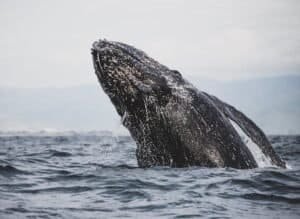Have you ever wondered How Many Fin Whales Are Left In The World? The most recent global estimate suggests that there may be around 100,000 to 119,000 fin whales left in the world. However, this number is only an approximation as it is difficult to accurately count these elusive animals in their natural habitat.
In recent years, there has been a growing concern about the decline in the population of fin whales worldwide. Once considered abundant in many regions across the globe, these creatures are now classified as endangered by the International Union for Conservation of Nature (IUCN).
Table of Contents
Threats to Fin Whales:
Despite being one of the fastest cetaceans, able to reach speeds of up to 37 km/h, fin whales have been struggling to survive due to various threats.
The main threats to fin whales include:
- Commercial Whaling: One of the main factors contributing to their decline is commercial whaling, which has been ongoing since the 19th century. It is estimated that over 700,000 fin whales were killed during this period.
- Overexploitation: Fin whales were heavily hunted for their blubber, oil and meat during the 19th and 20th centuries. This led to a significant decline in population and even today, illegal hunting remains a major threat.
- Pollution: Industrial activities such as shipping, offshore drilling and oil spills can release toxic chemicals into the oceans, contaminating the food chain and harming fin whales.
- Climate change: As ocean temperatures rise due to climate change, it can impact the distribution of prey for fin whales. This can lead to competition for resources and ultimately result in starvation or malnourishment.
- Collisions with ships: Fin whales are often struck by large vessels, resulting in severe injuries or death.
- Entanglement in fishing gear: These whales are prone to getting entangled in fishing gear such as nets, ropes and lines. This can impede their movement, cause injuries, or even result in drowning.

How Fin Whales look like:
The fin whale is the second largest animal on Earth, after the blue whale. It can reach lengths of up to 27 meters and weigh up to 74,000 kilograms. They have a streamlined body with a pointed head and a prominent dorsal fin located near the tail fluke.
A highly peculiar characteristic of fin whales is that their lower left mouth is black and their lower right jaw is brilliant white.
How do Fin Whales hunt?
Fin whales can catch more fish when they circle schools of them while their white sides are towards the prey, according to some scientists. Similar to other baleen whales, the fin whale uses its beaks to filter food from the water.
Habitat of Fin Whales:
Fin whales are known to inhabit all of the world’s oceans, except for the Arctic. They prefer deep, cold waters but can also be found in coastal areas during their migration. These graceful creatures are highly migratory and travel long distances in search of food and breeding grounds.

The life span of Fin Whales: How Many Fin Whales Are Left In The World?
With a maximum lifespan of around 90 years and a physical maturity age of around 25 years, fin whales are known to have lengthy lives. although specimens have been found aged at an estimated 135–140 years. Males become sexually mature at 6 to 10 years of age and females at 7 to 12 years of age.
What do Fin Whales eat?
When a Fin Whale opens its jaws, it swallows a tremendous quantity of water—up to 70 cubic meters—just like any other baleen whale. In a sieve-like motion, it ensnares its prey by sealing its mouth and expelling water through its baleens. The Fin’s baleen plates, which can spread out into tiny hairs, can be as long as 75 cm and as wide as 30 cm. Their meal consists of microscopic organisms, and they will dive to depths of up to 200 meters to get them. Each swallow can yield as much as 10 kilograms. When food is plentiful, fin whales can eat up to 1,800 kg in just three hours.
Why Were Fin Whales Killed?

Fin whales in the North Atlantic are listed as endangered because they were hunted by commercial whalers until the last century for their meat, oil, and baleen. As a result, certain populations are doing better. Fin whales are threatened by environmental change, including habitat loss, toxics, and climate change, just as other large whales.
Conservation efforts for Fin Whales:
Various organizations and governments are curious about how many Fin Whales are left in the world. They have taken steps to protect fin whales, including:
- Banning of commercial whaling in many countries and by international agreements such as the International Convention for the Regulation of Whaling.
- Protected areas: Some regions have designated protected areas where hunting or other human activities are not allowed in order to provide a safe haven for fin whales.
- Reduction in pollution levels: Efforts are being made to reduce the amount of toxic chemicals released into the oceans, through stricter regulations and better waste management practices.
- Ship speed restrictions: In areas where fin whales are known to frequent, speed limits have been implemented for ships to reduce collisions with these animals.
- Use of fishing gear with less impact: Some fisheries have started using gear that is less likely to entangle fin whales, such as acoustic deterrents or modified nets.
- Research and monitoring: Scientists are continuously studying and monitoring the population of fin whales to better understand their behavior and needs, which can help inform conservation efforts.
Final Thoughts
There must be around 100,000 Fin Whales are left in the world, this number seems like a huge population but it’ s not that population that were in the past. So this is one of the species in the list of endangered specie on our planet. Alot of the Fin Whale’s species were decline by the human activities and it is up to us to take responsibility and make changes before it’s too late. We must continue efforts to protect these majestic creatures and their habitat if we want future generations to be able to witness the beauty and power of the Fin Whales.
Read Also: How Many Humpback Whales Are Left In The World?





